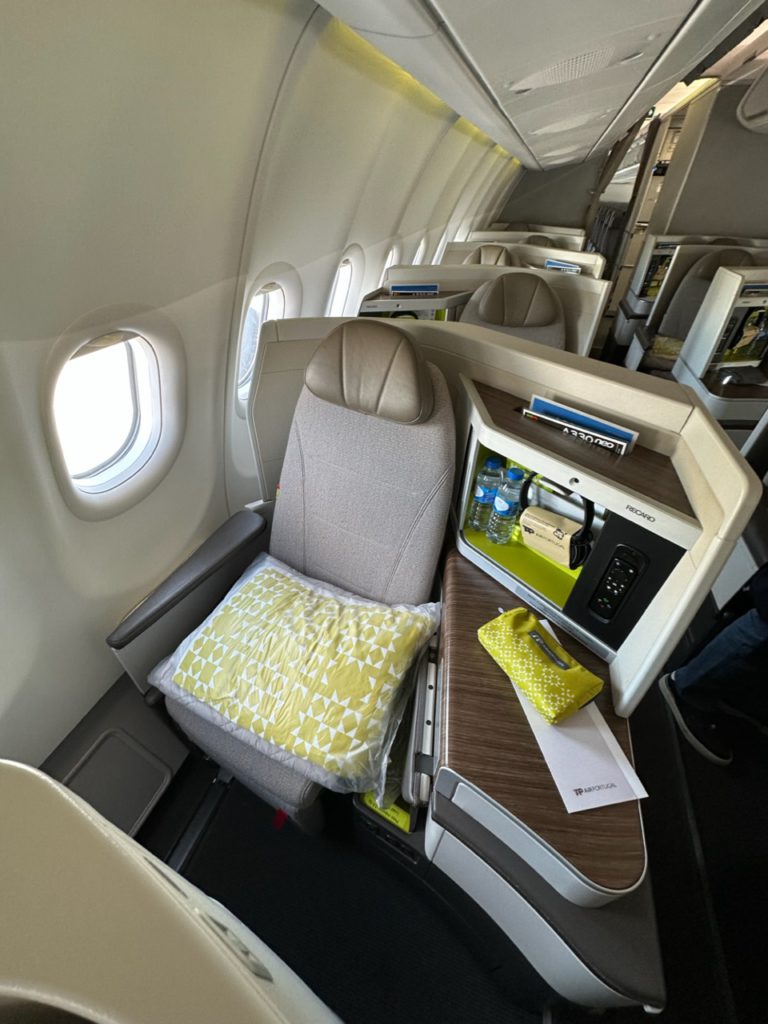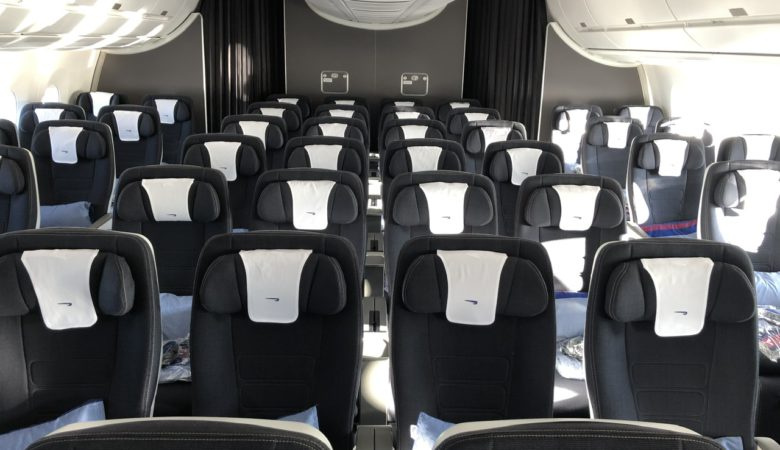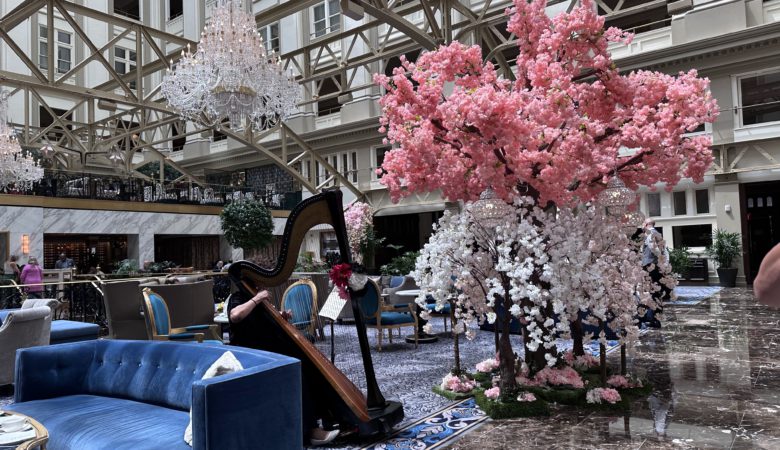For travellers who spend more time in the air than on the ground, the seat you choose is just as important as the airline you fly. Modern cabins come in a variety of business class seat types, from sleek reverse herringbone layouts to private suites with doors. Our guide breaks down six of the most prominent designs flying today, making it easier to know what you’re booking for your next long-haul journey.
1. Collins Aerospace Super Diamond
Layout: Outward-facing reverse herringbone, 1-2-1 configuration
Privacy: Moderate – many airlines add small privacy wings or full doors in custom versions
Best Features: Wide seat shell, all-aisle access, adaptable to various cabin styles
Airlines Using It: American Airlines, British Airways (Club Suite), Air Canada, China Airlines
Downsides: Storage space can be limited without airline-specific upgrades

The Super Diamond is a go-to choice for carriers wanting a proven, passenger-friendly design. Its balance of comfort, space, and operational efficiency makes it one of the most common business class seat types worldwide.
2. Safran Cirrus / Cirrus NG
Layout: Reverse herringbone, 1-2-1 configuration
Privacy: Good – angled away from the aisle for natural separation
Best Features: Spacious footwell, consistent ergonomics, easy cabin flow
Airlines Using It: Virgin Atlantic (A350), American Airlines (777-300ER), Finnair (early A350s), Vietnam Airlines, Cathay Pacific, Japan Airlines
Downsides: Older Cirrus versions feel dated compared to more recent products

As the original reverse herringbone, Cirrus still holds up well for comfort and ease of movement. Cirrus NG refreshes the concept with sharper styling and improved privacy.
3. Thompson Vantage XL
Layout: Staggered 1-2-1, alternating between window and aisle seats
Privacy: High – often delivered with sliding doors in modern cabins
Best Features: Spacious window seats, adaptable to multiple aircraft types
Airlines Using It: Delta (Delta One Suite), Qantas, SAS, Philippine Airlines
Downsides: Seats closest to the aisle can feel exposed if no door is fitted

Vantage XL has evolved into one of the most luxurious business class seat types thanks to its flexibility. Airlines can make it anything from a minimalist flatbed to a fully enclosed suite.
4. Adient Ascent
Layout: Configurable herringbone or staggered pairs, 1-2-1 layout
Privacy: High – doors are a common option
Best Features: Exceptional flexibility in cabin design, spacious paired suites in the middle section
Airlines Using It: Qatar Airways, Hawaiian Airlines, future American Airlines deliveries
Downsides: Still rare, with limited in-service examples

Ascent is the newcomer built for the suite era, with high walls, doors, and thoughtful touches like adjustable privacy between paired seats.
5. Recaro CL6720
Layout: Staggered, 1-2-1
Privacy: Moderate – not commonly fitted with sliding doors
Best Features: Lightweight build for fuel savings, multiple storage spaces, large entertainment screen
Airlines Using It: TAP Air Portugal, Air China, EL AL
Downsides: Still niche compared to rivals

Recaro may be better known for economy seating, but the CL6720 proves they can compete at the front. It’s one of the few business class seat types designed from the start with doors as standard.
6. Stelia Opal
Layout: Staggered, 1-2-1
Privacy: Moderate – not commonly fitted with sliding doors
Best Features: Premium finish, elegant design, and easy cabin integration
Airlines Using It: Air France (A350, retrofitted 777), Singapore Airlines (medium-haul A350s), China Airlines
Downsides: Limited deployment outside a handful of premium carriers

Opal has gained rapid recognition as a refined and comfortable option, especially in Air France’s latest cabins. It offers an understated yet premium approach to long-haul travel.
Here’s our quick cheat sheet
| Seat Type | Layout | Privacy | Best Features | Airlines Using It | Downsides |
|---|---|---|---|---|---|
| Collins Aerospace Super Diamond | Outward-facing reverse herringbone (1-2-1) | Moderate – often improved with doors in custom designs | Spacious seat shell, adaptable design, all-aisle access | American Airlines, British Airways (Club Suite), Air Canada, China Airlines | Limited storage without airline customisation |
| Safran Cirrus / Cirrus NG | Reverse herringbone (1-2-1) | Good – angled away from aisle | Comfortable layout, consistent ergonomics, large footwell | Cathay Pacific, American Airlines (777-300ER), Finnair (A350), Japan Airlines | Older versions feel dated |
| Thompson Vantage XL | Staggered (1-2-1) | High – doors on many installs | Excellent window seats, flexible cabin fit | Delta (Delta One Suite), Qantas, SAS, Philippine Airlines | Aisle-adjacent seats less private without doors |
| Adient Ascent | Herringbone or staggered pairs (1-2-1) | High – doors common | Flexible design, spacious paired middle suites | Qatar Airways (Qsuite 2.0), Hawaiian Airlines, American Airlines (future) | Limited aircraft currently in service |
| Recaro CL6720 | Staggered (1-2-1) | Moderate – not commonly fitted with sliding doors. Aisle seats are very exposed. | Lightweight build, integrated storage, large IFE screen | TAP Air Portugal, Air China, EL AL | Still relatively niche |
| Stelia Opal | Staggered (1-2-1) | Moderate – not commonly fitted with sliding doors | Elegant finish, premium comfort, adaptable design | Air France (A350, 777), Singapore Airlines (A350 medium-haul), China Airlines | Only on select fleets |
Verdict: Which Business Class Seat Type Wins?
All six designs here deliver lie-flat comfort, aisle access, and strong ergonomics. Your choice depends on priorities:
- Best for privacy: Thompson Vantage XL with doors
- Most versatile: Adient Ascent
- Most available: Collins Super Diamond
- Best design detail: Thompson Vantage XL
🏆 Overall Winner: Thompson Vantage XL – in its door-equipped form, it combines privacy, comfort, and availability like no other. It’s the seat most likely to make you forget you’re at 38,000 feet, and for many travellers, that’s the real measure of the best business class seat types.
A Notable Mention: Qatar Airways Qsuite
No discussion of business class seat types would be complete without mentioning Qatar Airways’ Qsuite. It didn’t make our shortlist of six because it’s exclusive to a single airline, but it remains one of the most influential seat designs of the past decade. When it launched in 2017, it set a new benchmark for privacy and flexibility – and it continues to be a leader today.

Layout: Reverse herringbone, staggered 1-2-1 with alternating forward- and rear-facing seats. Configurable middle pairs and quad layout.
Privacy: Very high – every seat has a sliding door, and partitions can be lowered to create doubles or quads.
Best Features: Configurable space (double beds or group suites), thoughtful design, stylish finishes, excellent storage.
Airlines Using It: Only Qatar Airways – fitted to all A350-1000s, and select A350-900s, 777-200LRs, and 777-300ERs.
Downsides: Limited availability (Qatar-only), and not all aircraft in the fleet feature it.
Coming Soon: Qsuite 2.0
Qatar Airways is preparing to launch a new generation of its signature product. Qsuite 2.0 builds on everything that made the original a success – privacy, flexibility, and style – while refining the design for lighter weight and easier maintenance.
Layout: Reverse herringbone, staggered 1-2-1 with alternating forward- and rear-facing seats. Flexible middle pairs for doubles and quads.
Privacy: Very high – sliding doors remain, with improved partition systems for smoother transitions between solo, couple, or group seating.
Best Features: Lighter seat structure for efficiency, upgraded finishes, and next-gen inflight entertainment systems.
Airlines Using It: Future deliveries of Qatar Airways A350s and 787-9s.
Downsides: Not yet flying – still in rollout phase, so travellers may face inconsistency across the fleet for several years.
Future Players To Watch
The world of business class seat types doesn’t stand still. While the six seats above dominate today’s skies, several next-generation designs are lining up to take their place in the spotlight. Here’s what’s coming soon to an aircraft near you.
Safran Unity
Safran’s newest flagship is designed to replace its long-serving Cirrus family. Unity is a full suite with doors, reverse herringbone layout, and optional paired centre seats that can open up into a double suite. Air India and Qantas have already signed on – the latter for its ultra-long-haul Project Sunrise A350-1000s. Expect Unity to become a staple for airlines chasing both privacy and prestige.
Stelia Symphony
Think of Symphony as Opal’s bigger, flashier cousin. It offers more storage, higher privacy walls, and full doors, while retaining Stelia’s knack for elegant detailing. Turkish Airlines is an early adopter, fitting Symphony to its newest A350s and 787-9s. Given Stelia’s growing footprint, this one could spread fast.
Collins Elevation
Collins already dominates the market with Super Diamond, and Elevation is its play for the next decade. It’s lighter, modular, and engineered to squeeze into more cabin layouts without losing space for passengers. No launch airline has been confirmed yet, but if Collins’ past success is anything to go by, expect Elevation to be everywhere within five years.
Thompson Optima
Lufthansa’s Allegris business class has put Optima on the radar. This staggered suite with doors is lighter and more cabin-efficient than the Vantage XL, making it a strong choice for airlines that need density without downgrading privacy. Flydubai was first to fly it, but don’t expect them to be the last.
Seats being installed on new A321XLR aircraft
The Airbus A321XLR is rewriting the rules of long-haul flying. With range to cross the Atlantic and serve thinner intercontinental routes, it gives airlines a lower-risk way to open new cities. But single-aisle aircraft create a challenge: how do you fit a proper lie-flat business class cabin into such a narrow tube?
The answer is a new wave of seat designs built specifically for the A321XLR. These business class seat types bring wide body comfort to a single-aisle jet. Here are the main contenders:
- Recaro CL6720 (narrowbody): Doors and high storage; less common, but logical for carriers already using Recaro on widebodies.
- Thompson VantageSOLO: Staggered 1-1 layout with sliding doors; chosen by JetBlue, Aer Lingus and TAP. A proven narrowbody solution adapted from Vantage XL.
- Safran VUE: Reverse herringbone with doors; picked by Air Canada for its XLR fleet. Built from scratch for single-aisle long-haul.
- Stelia OPERA: Reverse herringbone adapted for narrowbody fuselages; likely to appear with Air France-KLM. Premium feel without middle pairs.
- Collins Elements: American Airlines’ choice, forming a narrowbody version of its Flagship Suite for fleet consistency.

These future business class seat types aren’t just tweaks on today’s favourites – they’re designed to meet passenger demand for more privacy, better storage, and customisation, all while keeping the airline accountants happy. If you like your long-haul travel with a side of exclusivity, these are the seats to watch. We’ll aim to travel on most, if not all of them, and link our reviews here.





Leave a Reply